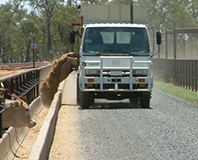Read the latest information on
Foot-and-mouth disease
 If you’re a stock feed manufacturer, retailer or livestock producer, then you need to understand the Australian Ruminant Feed Ban.
If you’re a stock feed manufacturer, retailer or livestock producer, then you need to understand the Australian Ruminant Feed Ban.
Legislated in all Australian states and territories, the ban states that ‘restricted animal material’ (RAM), being any meal derived from vertebrate animal origin, cannot be fed to ruminants. Doing so could result in the spread of bovine spongiform encephalopathy (BSE) in Australia, if it was ever introduced.
Australia has always been free of BSE and compliance with the ban will continue to help keep it out of Australian cattle, said Dr Rob Barwell, Animal Health Australia’s Senior Manager, Biosecurity.
“If BSE was introduced into Australia, it could have significant impacts on Australia’s livestock industry,” said Dr Barwell.
“Compliance with the ban is important as it ensures the provision of safe beef products to international markets and provides assurances to our global customers,” said Dr Barwell.
Stock feed manufacturers, retailers and producers all have responsibilities under the ban.
“It’s important that stock feed manufacturers and retailers ensure the appropriate warning labels are provided with the stock feed being sold and have processes in place to prevent cross-contamination of feeds,” said Dr Barwell.
“For cattle, goat and sheep producers, it’s crucial that they always read the label on stock feed to make sure the feed does not contain RAM.”
All production-based assurance schemes, such as Livestock Production Assurance and the National Feedlot Accreditation Scheme, audit livestock producers to check they are complying with the Ruminant Feed Ban.
If found in breach of the relevant food safety assurance standards, producers may lose the ability to use their National Vendor Declaration or be excluded from the food safety assurance schemes.
Penalties also apply to anyone found guilty of feeding products containing RAM to ruminants.
For more information, contact your local State Department of Primary Industry district veterinary officer or stock inspector, or producer organisation. Additional detail is also available from Animal Health Australia